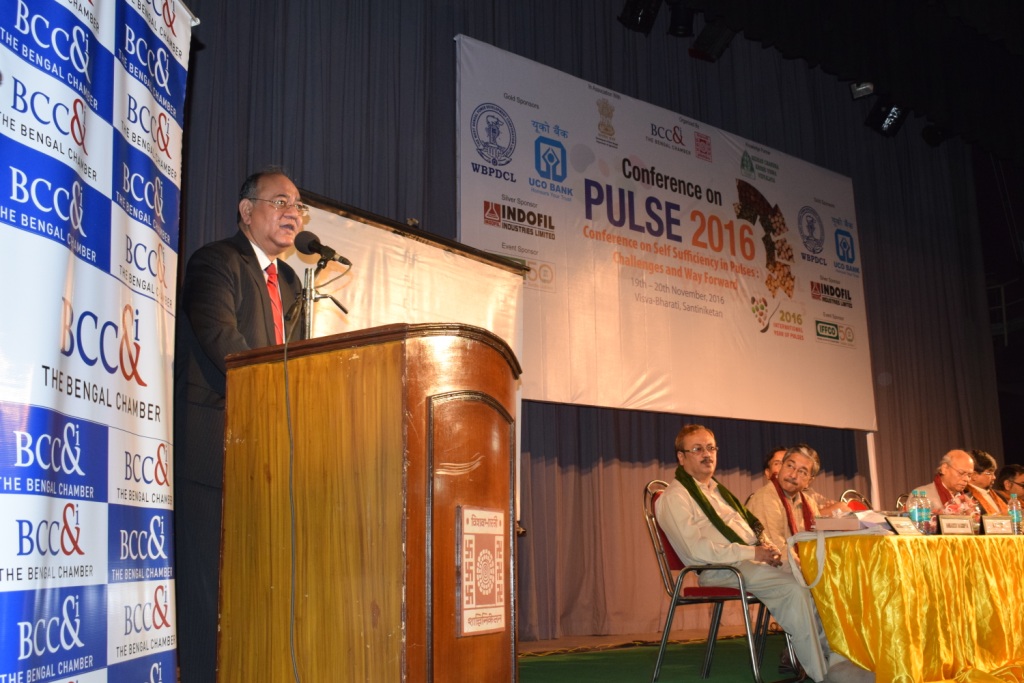19th November 2016, Santiniketan:
The Food and Agriculture Organisation (FAO) of the United Nations reaffirmed in their recent publication that pulses can help to improve health, nutrition, biodiversity, food security and climate change adaptation. Diet is an important contributor to health, and to disease. However, a large part of the population faces nutritional problems, from undernutrition and micronutrient deficiencies to obesity and diet-related diseases, or a mix of these. Pulses are a nutrient-rich food that, when included in a diet, can help fight malnutrition in both developed and developing countries.

From an economic perspective, pulses diversify smallholder income streams and mitigate risks associated with staple crop price fluctuations. When farmers grow pulses in addition to crops like maize, it helps buffer the farm from catastrophic disease, pest infestations and climate-related production disruptions.
The International Year of Pulses (IYP) 2016 shows great potential for West Bengal agriculture in particular. There is a need to celebrate IYP 2016 in the state, for addressing and removing the dietary imbalance, ensuring nutritional security – not just food security, harnessing remunerative returns from farming by rendering direct access to the deficit domestic market for the farmers or export through lndian Pulse & Grain Association as the case might be, and as an essential constituent of organic farming even with local cultivators.
In this backdrop, The Bengal Chamber of Commerce & Industry echoes the concern of the UN and is seeking to trigger off actions by creating awareness and enhanced research support. The Chamber had organised ‘Pulse 2016’ – Self Sufficiency in Pulses: Challenges and Way Forward, in association with Visva-Bharati, Santiniketan. The knowledge partner for this event is Bidhan Chandra Krishi Viswavidyalaya, West Bengal.

Speakers included: Prof. Sarthak Chowdhury,Principal P.S.B., Visva-Bharati; Dr. Rajeev Kumar Varshney, Director,Centre of Excellence in Genomics, The International Crops Research Institute for the Semi-Arid Tropics (ICRISAT), Hyderabad; Mr. Ambarish Dasgupta, Past President, The Bengal Chamber; Mr. Sutanu Ghosh , President, The Bengal Chamber, Dr. Swapan Kumar Dutta, Vice-Chancellor, Visva Bharati University; Dr. D.D. Patra, Vice-Chancellor, Bidhan Chandra Krishi Viswavidyalaya; Prof. Sabujkali Sen, Director (Studies, Educational Innovative & Rural Reconstruction); Prof. Subhendu Mondal, Siksha Bhavana; Dr. N.P. Singh, Director, Indian Institute of Pulses Research, Kanpur; among others.
“Pulses are incredibly rich in their nutritional value; they are small but densely packed with protein – double the amount found in wheat and three times that of rice. Pulses are also rich in complex carbohydrates, micronutrients, protein and B-vitamins, which are vital parts of a healthy diet,” said Mr. Sutanu Ghosh, President of The Bengal Chamber. “When grown in rotation with other crops, pulses help improve staple crop (e.g. rice/ wheat / maize) yields by breaking soil-borne pests and disease cycles that afflict these crops.”
Legumes, and particularly the pulse subgroup, provide multiple benefits: they improve soil fertility, boost health and nutrition, and can provide stable income for smallholder farmers. Before the advent of synthetic fertilizers in the early 20th century, pulses were the principal source of agricultural nitrogen for farmers. Today, pulses are still one of the main dietary staples for approximately 2 billion of the world’s poor, yet they receive a fraction of the investment that maize and other cereals receive.
The programme will deliberate on the way forward for the cultivation of pulses, and is expected to have important takeaways.
|
Benefits of Pulses: 1. Pulses are low in fat and rich in fibre, and are excellent for managing cholesterol, digestive health and regulating energy levels. 2. While pulses are low in calories (260-360 kcal / 100 gm dried pulses), they are high in complex carbohydrates and fibre, so they are slowly digested and give a feeling of satiety. 3. Pulses promote a steady, slow-burning energy while their iron content helps transporting oxygen throughout the body, which boosts energy production and metabolism. |
